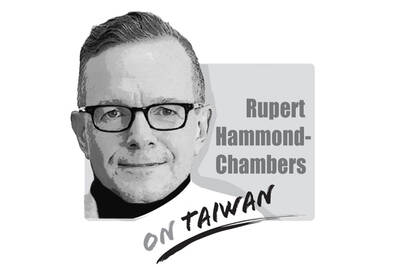Since Earth Day was founded in 1970, the UN has celebrated it each year in late April, a special holiday to inspire awareness and appreciation for the Earth’s environment. It has become similar to World Environment Day, now celebrated in June.
When considering the importance of this holiday and how it relates to Taiwan, think about the natural disasters that have occurred this month: The deadly earthquake in the remote Qinghai mountains in China and the momentous volcanic eruptions in Iceland.
When Taiwan was formed, today’s North America and Europe were separating from each other during the Jurassic Period. A great rift opened up, forming the Atlantic Ocean, divided by a gigantic sub-sea mountain ridge. Today, far north, near the Arctic Circle, appears a lonesome island “peak” covered with ice and glaciers: Iceland, where the dividing rift’s activity is fiercely demonstrated by the Eyjafjalla (“island-highland”) volcano.
Most news on the volcanic eruption has been about the economic losses, for example 81,000 canceled flights with US$2 billion in damages. If we would better understand our Earth, we would deplore the detrimental influence of humans on the environment and instead look forward with more respect and fear to better understand the challenges of where we live.
In 1997, two Europeans were inspired by China’s numerous protected regions — the needles in a haystack. In a country where the destruction of the environment is shocking the world, they have at least managed to preserve its most fascinating landscapes, as of this year there are almost 200 national Geoparks and 22 World Geoparks.
In 1997, Haute Provence in France became Europe’s first Geopark and a year later the UNESCO Geopark program was initiated. The alpine uplands of southern France document 300 million years of the Earth’s history. They now constitute Europe’s largest geological open-air museum (2,000km²) with fascinating rock formations and fossil sites. Besides 1550 ammonites on a single 320m² limestone wall, there are fossils of the ichthyosaur, an 18m long “fish-lizard” that haunted the Jurassic seas some 150 million years ago.
In Romania, we can find the pterosaur hatzegopteryx. The largest-ever flying animal, with a wing span of 12m, became extinct 65 million years ago, the remains of which have been discovered in the Hateg Country Dinosaurs Geopark at the foot of the 2,000m high Carpathian Mountains. Their destiny might have ended with volcanic eruptions, which have shaped this Romanian region with rock-tuffs, lava and volcanic bombs.
A while later, during the youngest period of our geologic history, 15 million to 20 million years ago, other volcanic disasters shattered southeastern Europe and formed what are now known as the Greek islands.
Among them is Lesvos (Lesbos), home to a unique petrified forest that once flourished as a tropical woodland. After it was buried under volcanic material, the dense vegetation fossilized.
As much of southern Europe was formed as a result of the African plate moving toward Europe, Taiwan is the result of the southeastern movement of the Eurasian plate. This one begins in Iceland and terminates where 150 million years ago continental sediments in the Formosan Strait were lifted up for the first time. Tiny islands have grown since then because of the time-honored process of sedimentary and volcanic build-up so now Taiwan constitutes a unique continental-oceanic multi-various and multi-cultural space.
Engelbert Altenburger is an associate professor at the Faculty of International Business at I-Shou University.

In the past month, two important developments are poised to equip Taiwan with expanded capabilities to play foreign policy offense in an age where Taiwan’s diplomatic space is seriously constricted by a hegemonic Beijing. Taiwan Foreign Minister Lin Chia-lung (林佳龍) led a delegation of Taiwan and US companies to the Philippines to promote trilateral economic cooperation between the three countries. Additionally, in the past two weeks, Taiwan has placed chip export controls on South Africa in an escalating standoff over the placing of its diplomatic mission in Pretoria, causing the South Africans to pause and ask for consultations to resolve
An altercation involving a 73-year-old woman and a younger person broke out on a Taipei MRT train last week, with videos of the incident going viral online, sparking wide discussions about the controversial priority seats and social norms. In the video, the elderly woman, surnamed Tseng (曾), approached a passenger in a priority seat and demanded that she get up, and after she refused, she swung her bag, hitting her on the knees and calves several times. In return, the commuter asked a nearby passenger to hold her bag, stood up and kicked Tseng, causing her to fall backward and
In December 1937, Japanese troops captured Nanjing and unleashed one of the darkest chapters of the 20th century. Over six weeks, hundreds of thousands were slaughtered and women were raped on a scale that still defies comprehension. Across Asia, the Japanese occupation left deep scars. Singapore, Malaya, the Philippines and much of China endured terror, forced labor and massacres. My own grandfather was tortured by the Japanese in Singapore. His wife, traumatized beyond recovery, lived the rest of her life in silence and breakdown. These stories are real, not abstract history. Here is the irony: Mao Zedong (毛澤東) himself once told visiting
When I reminded my 83-year-old mother on Wednesday that it was the 76th anniversary of the founding of the People’s Republic of China, she replied: “Yes, it was the day when my family was broken.” That answer captures the paradox of modern China. To most Chinese in mainland China, Oct. 1 is a day of pride — a celebration of national strength, prosperity and global stature. However, on a deeper level, it is also a reminder to many of the families shattered, the freedoms extinguished and the lives sacrificed on the road here. Seventy-six years ago, Chinese Communist leader Mao Zedong (毛澤東)